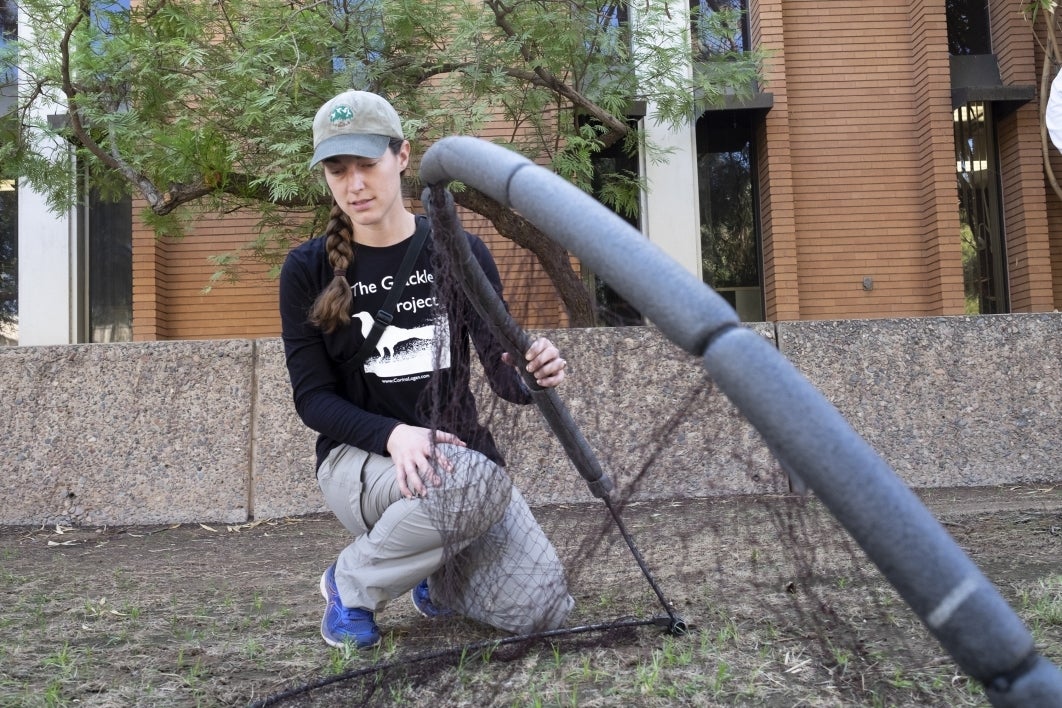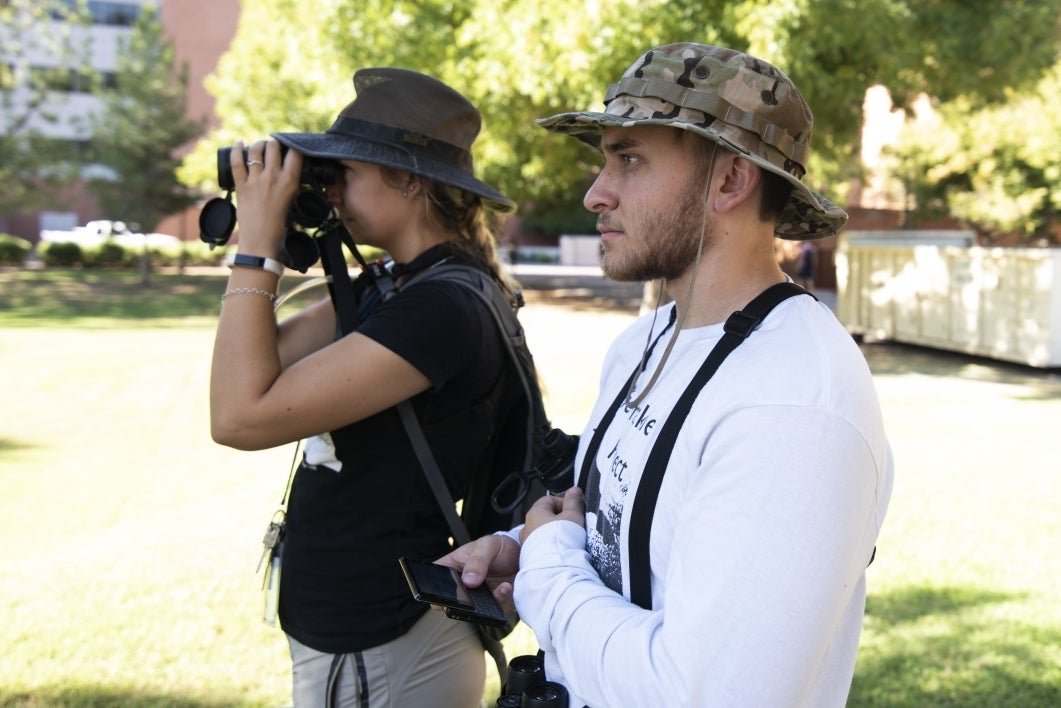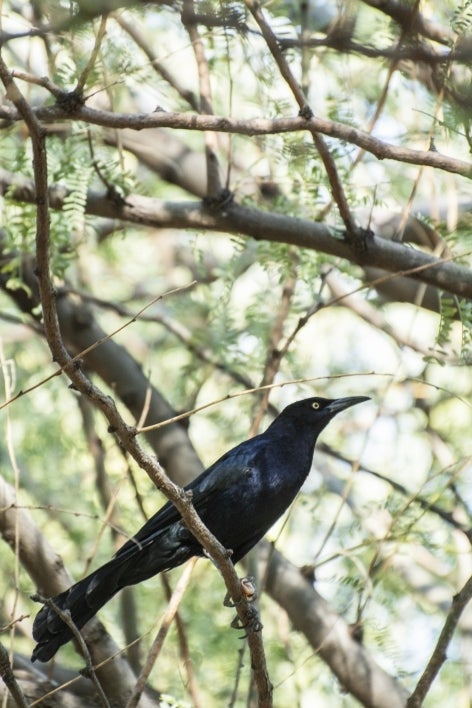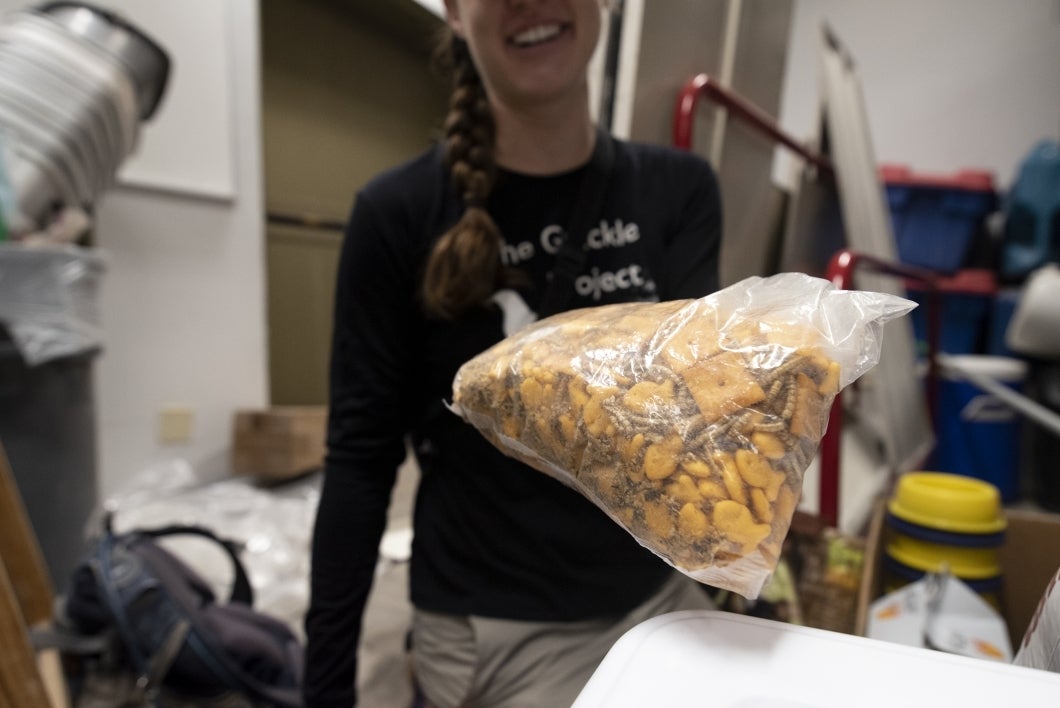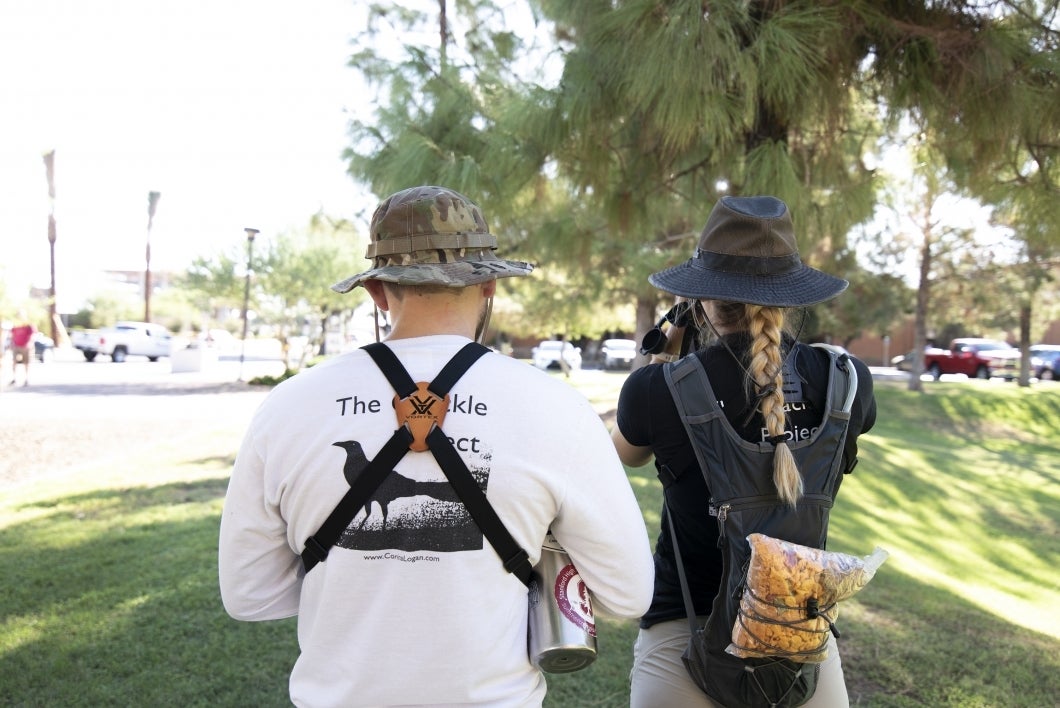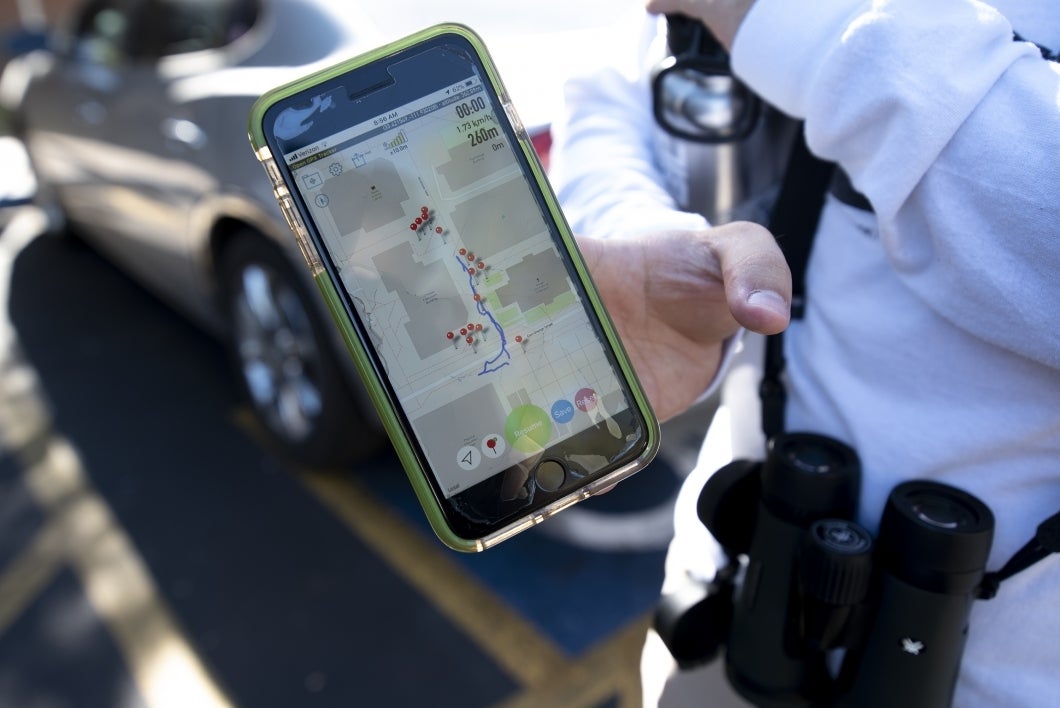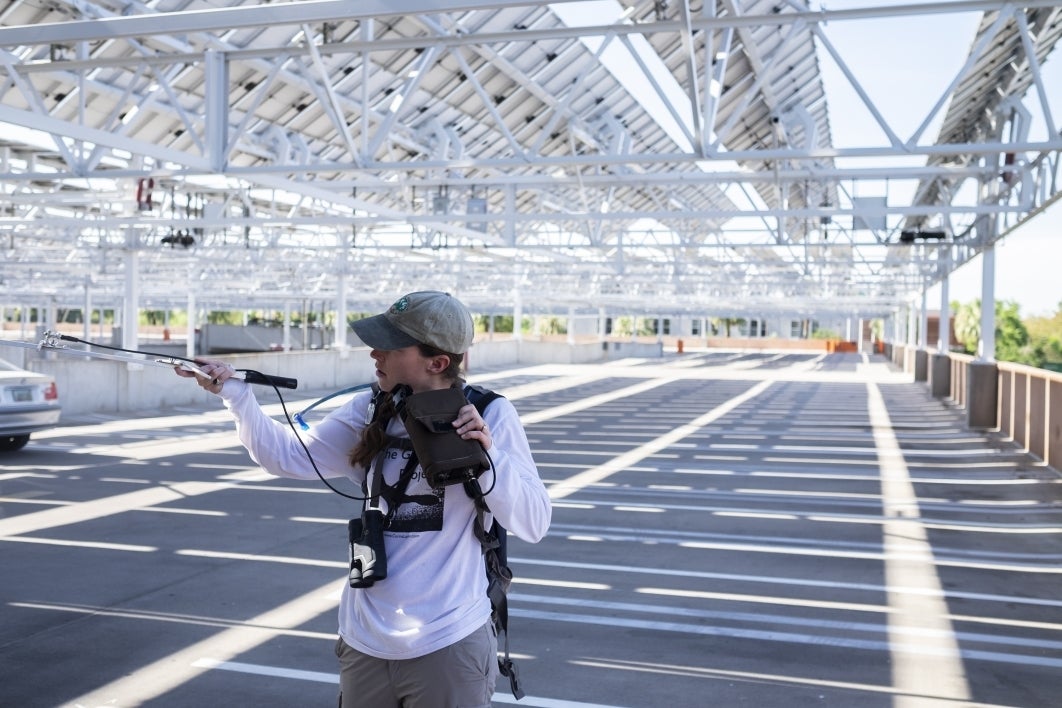Grackle researchers explore a species’ ability to adapt to new surroundings and thrive

A male great-tailed grackle clutches a piece of trash in its claw as it rests in a tree on ASU’s Tempe campus.
You might have spotted one rummaging through a garbage can on Arizona State University’s Tempe campus, or perched high above your head on Palm Walk. Maybe you’ve even caught one soaking up the sun, its head cocked up to the sky and wings rigid.
However it happened, chances are you’ve shared space with a great-tailed grackle at least a few times at ASU. In a project hosted by The College of Liberal Arts and Sciences’ School of Life Sciences, a team of researchers are showing there’s more to this common bird than meets the eye.
The species is a highly social, highly intelligent bird originally from Central America. Male grackles shine an iridescent black, females are a chestnut brown. They’re now seen in abundance at ASU because over the last 120 years populations have spread to North America, appearing throughout Mexico and Arizona and parts of California, Texas and Nevada.
Kelsey McCune is a postdoctoral fellow studying avian sociality, personality, cognition and conservation. She came to ASU last fall to study the great-tailed grackle.
“Grackles are known for being inside the city eating anything they can find, and in farms they’re known for eating crops — so to a lot of people, they’re pests, but that’s actually part of what makes them so interesting,” she said. “We are trying to understand what makes these birds so resilient, and how they continue to survive in urban settings.”
McCune is one of four researchers comprising the Grackle Project, a multiyear, multilocation study launched by researcher Corina Logan at the University of California, Santa Barbara in 2013. Logan’s field and lab work for the project has primarily explored the species’ ability to change mating, feeding and social behaviors in response to new habitat, a trait broadly defined as behavioral flexibility.
Logan is now based at Germany’s Max Planck Institute for Evolutionary Anthropology. In 2017, the School of Life Sciences began hosting the project's field site where undergraduate and staff researchers work to better understand how grackles in Arizona may possess unique qualities to those in other parts of the bird’s modern habitat.
An expanding range
Whether on farms or busy college campuses, grackles have thrived among humans, moving rapidly from Central America into the U.S. in areas like Arizona, now considered the center of the birds’ range. By studying this part of their territory, the team hopes to understand how location influences cognitive ability and foraging habits. Field work will remain at ASU for another year before moving to another section of the range in California and then Panama.
“We’re asking whether that ability to spread is because grackles are particularly flexible in their foraging. And we want to know if those in the original part of the range have the same abilities and physiology of those in Arizona, and whether it remains the same on the very edge of the range, in California,” McCune said. “Arizona is a good place to be because it’s a middle point, time-wise, between the original and new ranges — it has been enough time generationally for the grackles here to have potentially adapted in some way.”
To do this, the team observes the birds in their natural habitat around campus throughout the year. Additional cognitive and personality tests are done in campus aviaries during the cooler winter months. Since January 2018, researchers have fitted some 80 grackles with unique combinations of color bands before releasing them again. A subset of the banded group also received small backpacks with radio tags, allowing researchers to track them and monitor feeding, mating and social habits in real time.
Evolving behavior and personality
Melissa Folsom is an alumna of The College who graduated with a bachelor’s degree in biological sciences and a minor in sustainability in 2017. This summer, she returned to campus to work as a full-time field manager for the Grackle Project.
She worked with McCune collecting data on the grackles fitted with radio chip backpacks throughout the summer. Now in the mating off-season, the team is following color-banded birds on campus and preparing to catch new subjects to be monitored in aviaries for the winter months.
“Right now we are doing focal follows, which means we search for grackles to quietly observe on campus and I input that data into our digital system later on,” Folsom said. “Additionally, I’ll map out a bird’s movement on campus by following it and collecting GPS coordinates of the bird’s location every minute as I walk — this gives us a sense of what they do and where they go during the day.”
Folsom said the team has logged data of male grackles moving into traditional female roles of feeding their young and birds of both sexes engaging in socialization and play. Documenting these habits in Arizona will add to a larger body of work about how behavioral flexibility influences population growth, McCune said.
“Corina (Logan) has a hypothesis that the ability to change behavior in response to new circumstances, is particularly important for range expansion,” she said. “It takes more creativity to pick fries out of a McDonald’s carton, for example, than to eat insects out of the grass. Looking at it from a social perspective, we see that when there are these individual differences, where some birds are good at being flexible, smarter or bolder, that other birds may form groups around them to learn from them.”
Interdisciplinary applications
McCune said the Grackle Project is about more than researching the bird itself. Because few other species have accomplished the same degree of range expansion, understanding more about its adaption could play a role in saving species who aren’t as resilient.
“Conservationists are trying to help endangered species by breeding them in captivity and then releasing them into the wild,” McCune said. “In logging data about grackles across Central America, Arizona and California, we are able to see how some of them are better at dealing with humans than others, and we can apply the same tests to endangered species to see which ones are most likely to survive once released.”
Behavioral research also has interdisciplinary applications beyond the animal kingdom.
“Medical schools look for research in biological fields,” said Michael Pickett, a junior studying biomedical science at The College and a student researcher on the project. “So especially the stuff we do once we have the birds in our aviaries, such as health tests and drawing blood to look at their genetic makeup, it really ties into some of the same biomedical aspects of medical research.”
Kevin LangergraberLangergraber is also an assistant professor and research associate in The College's Institute of Human Origins, and an associate professor in the Center for Evolution and Medicine and the Biosocial Complexity Institute., an associate professor in The College’s School of Human Evolution and Social Change and a faculty sponsor of the project, said learning how grackles have successfully pushed into new areas has implications for the study of human history.
"One of the big questions in anthropology is how was it that, some 70,000 years ago, humans who left Africa were able to populate the rest of the planet so rapidly,” Langergraber said. “We can only get so far in answering this question by sticking only to studying humans; that’s why it’s so important to look at other species like grackles to discover the qualities that lead to dispersal and success in a range of novel environments."
More Science and technology

ASU at the heart of the state's revitalized microelectronics industry
A stronger local economy, more reliable technology, and a future where our computers and devices do the impossible: that’s the…

Breakthrough copper alloy achieves unprecedented high-temperature performance
A team of researchers from Arizona State University, the U.S. Army Research Laboratory, Lehigh University and Louisiana State…

4 ASU researchers named senior members of the National Academy of Inventors
The National Academy of Inventors recently named four Arizona State University researchers as senior members to the prestigious…


